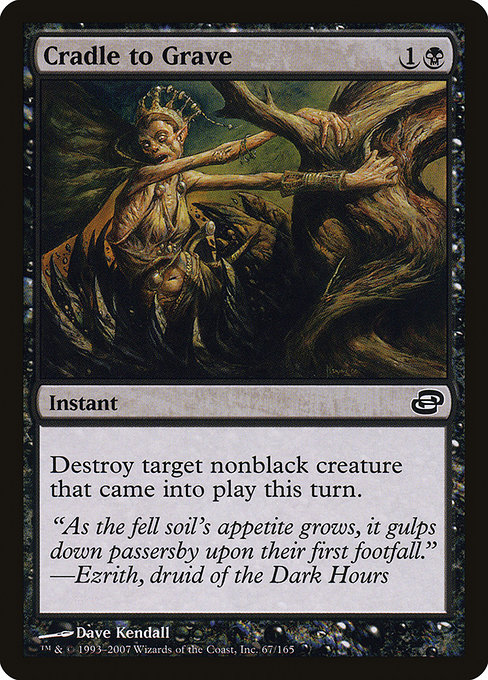
Image courtesy of Scryfall.com
Templating Deep Dive: Cradle to Grave as a Case Study
Magic: The Gathering’s text is a rules-laden tapestry, and templating is the loom that keeps the pattern readable across decades and formats. Cradle to Grave, a lean two-mana interruption from Planar Chaos, is a perfect lens for how a single line of text can shape understanding for new players and veterans alike 🧙♂️. With a mana cost of {1}{B} and an Instant speed, it sits in the black color pie as a tempo-removal option that punishes a creature that just stepped onto the battlefield this turn. The card’s rarity is common, but the lessons it teaches about language, timing, and targeting are worth their weight in diamonds (or, you know, precious spells and pivoting plan changes) 💎.
In plain terms, Cradle to Grave says: destroy target nonblack creature that entered this turn. The structure is simple, but the choice of words matters. It uses a color-labeled constraint—nonblack—to carve out exactly which threats are fair game. It uses a temporal qualifier—entered this turn—to narrow the target to creatures that were just created or summoned onto the battlefield within this turn’s window. And it keeps the effect narrow and focused: destroy, not exile or return to hand. That combination of constraints is what makes the card predictable in a good way, even when you’re reading it for the first time and your brain is still catching up with the rules 💡⚔️.
Reading the Text: What players actually see on the battlefield
- Mana cost and color identity: {1}{B} marks Cradle to Grave as a black instant with casual-lane tempo. The color identity guides deck-building, synergies, and how an opposing player might plan around it 🧙♂️.
- Type and timing: Instant allows you to respond during your opponent’s turn or the stack, a classic tempo tool for black’s strategic toolkit 🔥.
- Targeting constraint: “Destroy target nonblack creature” means you cannot remove black creatures with this spell. That limitation is not a flaw—it’s a design choice that preserves color mechanics and opens up thoughtful play around threats and protection effects.
- Temporal qualifier: “that entered this turn” restricts the spell’s applicability to creatures that joined the battlefield during the current turn. Tokens created this turn count; creatures that entered on a prior turn do not. This nuance matters in aggressive openers, midrange scrapes, and multiplayer chaos where the battlefield can change in a blink 🧲.
As a player, the key is to train your eye to scan for three things quickly: the mana cost, the color constraint, and the enter-the-battlefield window. When those align, Cradle to Grave becomes a reliable tempo play that can swing the pace of a match. And when they don’t—say you’re facing a black-control shell or a swarm of black-tinged threats—you’ll know to reserve your answer for a different moment, or pivot to another form of removal that complements the tempo you’re trying to establish 🃏.
“As the fell soil's appetite grows, it gulps down passersby upon their first footfall.” — Ezrith, druid of the Dark Hours
The flavor text isn’t just a mood; it mirrors the card’s ruthless efficiency. Planar Chaos, the set this card hails from, plays with time and order, giving players a sense that knowledge of exact wordings can tilt outcomes as surely as any spell. The tinny precision of templating is how you translate lore into play—keeping the world’s feel intact while making the rules accessible. Cradle to Grave embraces that balance with a compact package that rewards careful reading and proactive thinking 🔮🎲.
Practical play patterns for various formats
In limited or casual Constructed, Cradle to Grave shines when an opponent taps out for a big threat or sneaks a bomb onto the battlefield. The narrow condition—nonblack and entered this turn—lets you time it to hit a freshly played blocker or a surprise attacker, turning a potentially dire moment into clean tempo advantage. In Commander, the card reads differently because a lot more creatures hit the battlefield in a single turn, yet the same templating rules apply. You’ll want to pick your moments carefully, especially when your pod runs heavy black or when you’re facing a nonblack swarm that would otherwise sponge the spell’s effect 🛡️⚔️.
From a deck-design perspective, templating informs card-slot decisions. If you’re building a control or midrange plan that expects to resolve a handful of instants to manage the board, Cradle to Grave provides a precise answer to a specific kind of threat. It’s not a universal panacea, but its clarity makes it a reliable piece in the right shell. And because the card is common in PLC, it’s a staple you’ll see popping up in budgets-friendly lists across lots of playgroups, a reminder that good templating is a form of accessibility for new players and a quick path to mastery for seasoned fans 🧙♂️💬.
While you sink into the card’s art and rhythm, consider how your workspace can mirror that clarity. A clean, comfortable mouse pad can keep your focus sharp while you puzzle over a tricky line of text or poke at a sticky stack. To that end, a round or rectangular neoprene mouse pad—customizable for your desk—offers both form and function as you draft, stack, or playtest. Click through to explore a way to personalize your battlestation and keep pace with the ever-expanding ruleset of the Multiverse 🔥🎨.
Custom Neoprene Mouse Pad (Round or Rectangular, Non-slip)
More from our network
- https://crypto-acolytes.xyz/blog/post/mastering-preemptive-multitasking-on-arm-cortex-m-systems/
- https://crypto-acolytes.xyz/blog/post/enhance-your-minecraft-adventures-with-biome-expansion-mods/
- https://blog.digital-vault.xyz/blog/post/elemental-augurys-artist-top-mtg-cards/
- https://blog.digital-vault.xyz/blog/post/tracing-arcanines-regional-migrations-across-pokemon-regions/
- https://crypto-acolytes.xyz/blog/post/beat-the-elite-four-in-pokemon-red-and-blue/